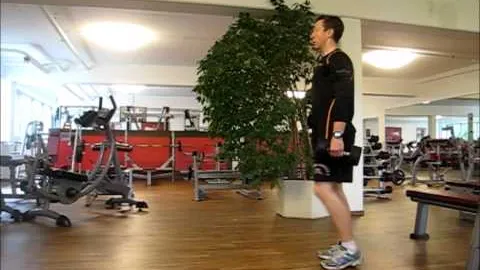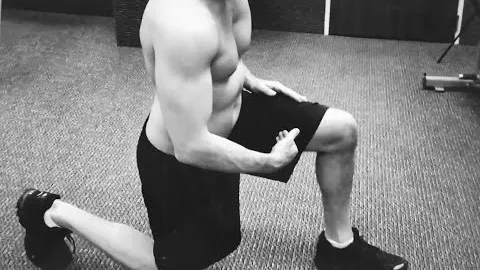




Are you looking to level up your lower body strength? Look no further than the forward dumbbell lunge exercise. This simple yet effective move targets various muscle groups in your lower body and is a great addition to any workout routine.
Incorporating forward dumbbell lunges into your fitness routine provides numerous benefits. Here are a few reasons why you should consider adding this exercise to your workouts:
Leg and Glute Strengthening: The forward dumbbell lunge primarily targets your quadriceps, hamstrings, and glutes. By regularly performing this exercise, you can strengthen and tone these muscle groups, leading to improved lower body strength and stability.
Balance and Coordination: The forward lunge requires you to maintain your balance throughout the movement. By practicing this exercise regularly, you can improve your balance and coordination, making it easier to perform daily activities and other exercises.
Functional Movement: The forward lunge mimics movements that we do in our everyday lives, such as walking, climbing stairs, or picking up objects from the ground. By training these functional movements, you can enhance your overall fitness and make daily tasks easier.
Core Activation: To perform the forward lunge properly, you need to engage your core muscles to maintain stability and control. This exercise helps strengthen your core, leading to better posture and reduced risk of lower back pain.
Calorie Burn: As a compound exercise, the forward dumbbell lunge engages multiple muscle groups simultaneously, which requires more energy expenditure. Incorporating this exercise into your routine can help increase your overall calorie burn during workouts and aid in weight loss.
Now that you understand the benefits of the forward dumbbell lunge, let's go over the proper technique for performing this exercise:
Starting Position: Begin by holding a dumbbell in each hand, keeping your arms straight and relaxed by your sides. Stand with your feet shoulder-width apart, maintaining a neutral spine and engaging your core.
Step Forward: Take a controlled step forward with your right foot, ensuring your knee doesn't go past your toes. Keep your torso upright and your gaze forward.
Lower Your Body: As you step forward, simultaneously lower your body towards the floor by bending both knees. Aim to create a 90-degree angle with your front knee, keeping your back knee hovering just above the ground.
Back to Starting Position: Push through your front heel and engage your leg muscles to return to the starting position. Exhale as you stand back up, maintaining control and balance throughout the movement.
Alternate Sides: Repeat the movement on the other side by stepping forward with your left foot. Continue to alternate between your right and left leg for the desired number of repetitions.
To maximize the effectiveness of the forward dumbbell lunge and prevent injury, keep the following tips in mind:
Maintain Proper Alignment: Keep your shoulders back, chest up, and gaze forward throughout the movement. Avoid leaning too far forward or allowing your back to round.
Step Far Enough: Ensure that when you step forward, your stride is long enough to achieve a 90-degree angle with your front knee. This will help engage your leg muscles and target the intended muscle groups effectively.
Control the Movement: Prioritize control and stability over speed. Focus on maintaining balance throughout the exercise and avoid rushing through the lunges.
Start with Light Weights: If you are new to dumbbell lunges, start with lighter weights until you feel comfortable with the movement. Gradually increase the weight as you become more proficient.
Warm-Up: Before performing any exercise, it's essential to warm up your muscles. Engage in a dynamic warm-up routine that includes movements like walking lunges or hip circles to prepare your body for the workout ahead.
Consult with a Professional: If you have any pre-existing medical conditions or concerns, it's always best to consult with a fitness professional or your healthcare provider before attempting new exercises. They can provide personalized guidance and ensure your safety.
To make the most out of the forward dumbbell lunge exercise, try incorporating it into your lower body or full-body workout routine. Here's a sample workout plan to get you started:
Warm-up: Begin with a 5-10 minute dynamic warm-up routine, including exercises like arm circles, leg swings, and high knees.
Forward Dumbbell Lunges: Perform 3 sets of 10-12 repetitions on each leg, with a 60-90 second rest in between sets.
Superset: Pair the forward dumbbell lunges with another leg exercise such as squats or deadlifts. Perform 3 sets of 8-10 repetitions of each exercise, alternating between the two with minimal rest in between.
Additional Leg Exercises: Add one or two more leg exercises of your choice, such as step-ups or calf raises. Perform 2-3 sets of 10-12 repetitions for each.
Cool Down and Stretch: Finish your workout with a 5-10 minute cool-down period, followed by static stretches targeting your lower body muscles. Hold each stretch for 15-30 seconds.
Remember to start with weights that challenge you, yet allow you to maintain proper form. As you gain strength and confidence, gradually increase the weights to continue progressing.
The forward dumbbell lunge is a versatile and effective exercise that can help strengthen your lower body, improve balance and coordination, and enhance your overall fitness level. By following proper form and incorporating this exercise into your routine, you can reap the numerous benefits it offers. Remember to listen to your body, start conservatively, and gradually increase intensity as your fitness level improves. Start lunging forward, and watch your lower body strength soar!
If you're looking for a gym, fitness club or yoga studio, you've come to the right place.
You can find information about gyms in your area. Browse catalog of gyms and find gyms with classes which are you looking for.
On gym page you can find simple information like address, phone or website. You can find list of available classes. You can check availability of personal training or small group classes. On place page you can also see information about open hours.
You can find gyms near you with amenities, courts, studios and equipments.
Use our map to find gym at your city or district.
In Gym Navigator you can find list of exercises with movies for many body parts.
You can browse exercises catalog and find exercises the best of you.
You can also find exercises grouped into workout plans, which you can use to improve you body. Each routine show you exercises one by one and give you possibility to count you progress and count down rest time.